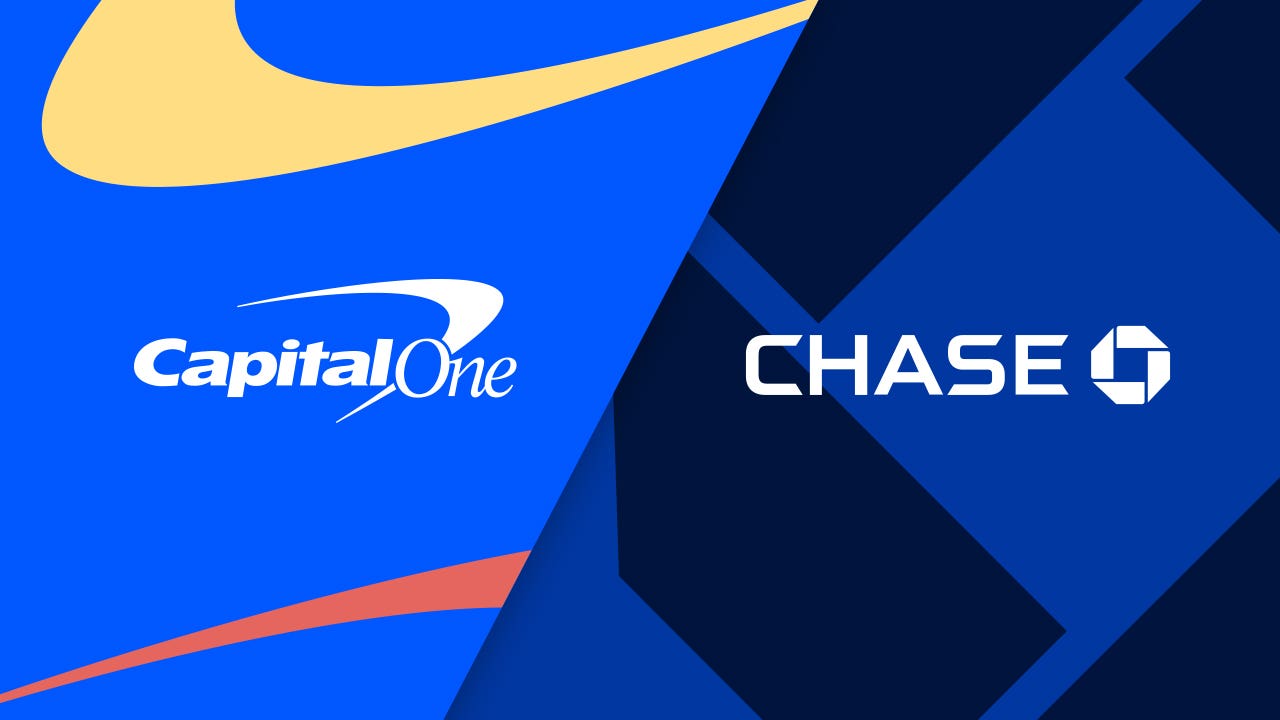Capital One vs. Chase

The Bankrate promise
At Bankrate we strive to help you make smarter financial decisions. While we adhere to strict , this post may contain references to products from our partners. Here's an explanation for .
Measured by total assets, Chase and Capital One are among the largest banks in the U.S., with Chase taking the number one spot and Capital One taking number nine. Both banks offer a variety of deposit products, including certificates of deposit (CDs) as well as checking and savings accounts. Neither offers a money market account.
Chase has more branches to boast of, but Capital One makes up for its lack of branches with top-notch deposit accounts that offer high yields and no monthly fees. Here’s a comparison of Chase and Capital One, including by account type.
Chase vs. Capital One: Overview
| Chase | Capital One | |
|---|---|---|
| Overall Bankrate score | 3.5 | 4.7 |
| Overview | Chase conveniently has a banking presence in nearly every state. You can also use Chase’s app and website to easily send anyone money, pay bills, create a budget and more. But if you’re looking for the highest savings rates, better options are available elsewhere. | Capital One is a strong choice for consumers looking to earn competitive rates and pay no monthly fees. It offers access to a vast no-fee ATM network as well as branch locations in select states. |
| Pros |
|
|
| Cons |
|
|
Chase vs. Capital One: Savings accounts
Capital One offers just one savings account. Chase offers two main savings accounts: Chase Savings and Chase Premier Savings.
The bottom line: When it comes to savings accounts that earn a high annual percentage yield (APY) and no monthly fees, Capital One’s 360 Performance Savings blows Chase’s accounts out of the water.
| Chase Savings | Capital One 360 Performance Savings | |
|---|---|---|
| Bankrate score | 2.9 | 4.4 |
| APY | 0.01% | 4.25% |
| Monthly fees | $5 or $0 when requirements are met | $0 |
| Minimum deposit to open | $0 | $0 |
| Features |
|
|
| What to watch for |
|
|
Note: Annual percentage yields (APYs) shown are as of June 24, and may vary by region for some products.
Chase vs. Capital One: CDs
Both Chase and Capital One offer a wide range of CDs with various terms and yields. Chase offers a wider range of terms, but Capital One doesn’t require a minimum deposit, making its CDs much more accessible. Moreover, while Chase requires a hefty deposit amount to earn top yields, Capital One offers top rates regardless of how much money you deposit into the CD.
| Chase CDs | Capital One 360 CDs | |
|---|---|---|
| Bankrate score | 2.8 | 4.9 |
| Term lengths | One month to 10 years | Six months to five years |
| Minimum deposit to open | $1,000 | $0 |
| APY for one year | 2.00% | 5.00% |
| APY for three years | 2.00% | 4.00% |
| APY for five years | 2.50% | 3.90% |
| IRA CDs | None available | None available |
| Specialty CDs | None available | None available |
| Featured CDs | Available: 3.00% – 4.75% APY* | None available |
*To earn the highest APY for some terms, you must have a linked eligible Chase checking account and $100,000 in deposits.
Note: Annual percentage yields (APYs) shown are as of June 24, and may vary by region for some products.
Chase vs. Capital One: Checking accounts
Chase offers a variety of checking accounts that will appeal to a wide range of consumers, and the best one for you will depend on your individual needs. In contrast, Capital One offers just one checking account. For this comparison, we’ve reviewed Chase Total Checking and Capital One 360 Checking.
In general, many consumers will find Capital One’s account more favorable, as it comes without fees and even earns a decent yield for a checking account.
| Chase Total Checking | Capital One 360 Checking | |
|---|---|---|
| Bankrate score | 3.8 | 5.0 |
| Monthly fees | $12 or $0 when requirements are met | $0 |
| Minimum deposit to open | $0 | $0 |
| APY | None | 0.10% |
| Overdraft fee | $34 | None |
| Features |
|
|
| What to watch for |
|
|
Chase vs. Capital One: Banking experience
Being the largest bank in the country, Chase offers branches in nearly every state in the U.S. In contrast, Capital One has a much more limited geographic footprint, being available in only nine states. As such, you’ll find Chase branches to be more easily accessible. But it’s worth noting that Capital One helps offset its lack of branch presence with a large ATM network. Moreover, both banks have highly rated mobile apps that help you track and manage your money.
| Chase | Capital One | |
|---|---|---|
| Branches | Approximately 4,700 | Approximately 300 |
| Customer service | Available by phone, mail and in person. Customer service hours over the phone are not prominently listed on Chase’s website. | Available by phone, e-mail and mail. Phone customer service hours are every day from 8 a.m. to 8 p.m. ET. |
| ATM network | Approximately 16,000 ATMs | Approximately 70,000 ATMs |
| Mobile app rating | iOS: 4.8 Android: 4.4 |
iOS: 4.8 Android: 4.5 |
| Philanthropy | JPMorgan Chase Foundation | Capital One Foundation. Also part of the Change Capital Fund. |
— Bankrate’s Karen Bennett contributed to an update of this story.
Related Articles



Premium credit card comparison: Chase Sapphire Reserve vs. Capital One Venture X vs. Amex Platinum
